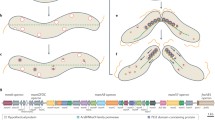Abstract
The morphological, biochemical, and magnetotactic properties of a single magnetic bacterium are reported. Although this bacterium has not been cultured axenically, the unusual magnetotactic behavior has allowed the collection of cell material of sufficient quantity and purity to allow characterization. The results indicate that this organism represents a new genus of colorless, sulfur-depositing bacteria, albeit of uncertain affiliation. The name proposed for this new genus/species,Bilophococcus magnetotacticus, reflects the most distinctive traits of morphology, motility, and magnetic mineral formation. Classification is based on type descriptive material.
Similar content being viewed by others
References
ALPHA (1981) Microbiological examination of water. In: Standard Methods for Examination of Water and Wastewater. American Public Health Assoc. Washington, D.C.
Balkwill DL, Maratea D & Blakemore RP (1980) Ultrastructure of a magnetotactic spirillum. J. Bacteriol. 141: 1399–1408
Blakemore RP (1982) Magnetotactic bacteria. Ann. Rev. Microbiol. 36: 217–238
Blakemore RP, Maratea D & Wolfe RS (1979) Isolaton and pure culture of a freshwater magnetic spirillum in chemically defined medium. J. Bacteriol. 140: 720–729
Buchanan RE & Ribbons NE (Eds) (1974) Bergey's Manual of Determinative Bacteriology. 8th edn. The Williams and Wilkins Co., Baltimore
Clarke PH & Rowan ST (1969) Catalase microtests. In: Skerman VDB (Ed) Abstracts of Microbiological Methods (p 144)
Frankel RB, Papaefthymiou GC, Blakemore RP & O'Brien W (1983) F3O4 precipitation in magnetotactic bacteria. Biochim. Biophys. Acta 763: 147–159
Freke AM & Tate D (1961) The formation of magnetic iron sulfide by bacterial reduction of iron solutions. J. Biochem. Microbiol. Tech. Eng. (now Biotech. Bioeng.) 3: 29–39
Jones HE, Trudinger PA, Chambers LA & Pyliotis NA (1976) Metal accumulation by bacteria with particular reference to dissimilatory sulphate-reducing bacteria. A. Zllg. Mikrobiol. 16: 425–435
Kirschvink JL (1983) Biogenic ferrimagnetism: a new biomagnetism. In: SJ Williamson, Romanig G-L, Kaufman L & Modena I (Eds) Biomagnetism. Plenum Publishing Corp.
Konetzka WA (1977) In: Weinberg ED (Ed) Microbiology of Metal Transformations in Microorganisms and Minerals (pp. 317–342), Marcel Dekker, Inc., New York
Lapage SP, Sneath PHA, Lessel EF, Skerman VBD, Secliger HPR & Clark WA (1975) International Code of Nomenclature of Bacteria. American Society for Microbiology. Washington, D.C. 180 pp
La Riviere JWM & Schmidt Karin (1981) Morphologically conspicuous sulfur-oxidizing eubacteria. In: Starr MP, Stolp H, Trüper HC, Balows A & Schlegel HG (Eds) The Prokaryotes. A Handbook on Habitats, Isolation, and Identification of Bacteria. Vol. 1 (pp. 1037–1048), Springer-Verlag, NY
Law JH & Slepecky RA (1961) Assay of poly-β-hydroxybutyric acid. J. Bacteriol. 82: 33–36
Lowry OH, Rosebrough NJ, Farr AL & Randall RJ (1951) Protein measurement with folin phenol reagent. J. Biol. Chem. 193: 265–275
Macrae RM & Wilkinson JF (1958) Poly-β-hydroxybutyrate metabolism in washed suspensions of Bacillus cereus and Bacillus megaterium. J. Gen. Microbiol. 19: 210–222
Mann S, Moench TT & Williams RJP (1984) A high resolution electron microscopic investigation of bacterial magnetite; implications for crystal growth. Proc. Royal Society, London. 221: 385–393
Maratea D & Blakemore RP (1981)Aquaspirillum magnetotacticum sp. nov., a magnetic spirillum. Int. J. Syst. Bacteriol. 31: 452–455
Moench TT (1978) Distribution, isolation and characterization of a magnetotactic bacterium. Ph.D. thesis. Indiana University. 110 pp. University Microfilms, Ann Arbor, Michigan
Moench TT & Konetzka WA (1978) A novel method for the isolation and study of a magnetotactic bacterium. Arch. Microbiol. 119: 203–212
Towe KM & Moench TT (1981) Electron optical characterization of bacterial magnetite. Earth and Plan. Sci. Lett. 52: 213–220
Author information
Authors and Affiliations
Rights and permissions
About this article
Cite this article
Moench, T.T. Bilophococcus magnetotacticus gen. nov. sp. nov., a motile, magnetic coccus. Antonie van Leeuwenhoek 54, 483–496 (1988). https://doi.org/10.1007/BF00588385
Issue Date:
DOI: https://doi.org/10.1007/BF00588385




